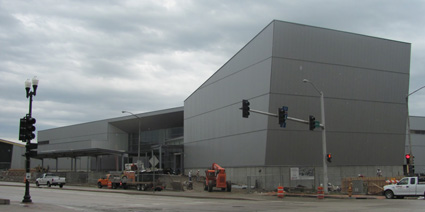The Peoria Riverfront Museum is nearing completion, and we’re starting to get a pretty good picture of what the finished product will look like. In particular, we’re getting a look at the exterior building materials: grey metal building panels. They don’t look quite as sleek in real life as they did on the artist’s renderings that were shared with the public five years ago:

But read how the building designer describes these exterior panels:
When finished, building designer Bob Frasca envisions the panels “will reflect a shimmer of light across the building’s surface much like light dances across the Illinois River. The site’s exterior design was intended to reach out to embrace the river, harmonizing with the reflective surface of the water; changing by the hour and season. Such connections to our Illinois River are fundamental. The river was the impetus for Peoria’s development and it continues to nurture our community today.”
Here’s the thing: the museum is not on the river, except during a flood. The rest of the time, the Italianate-style Rock Island Depot (aka “River Station”) and the postmodern Riverfront Village stand between the “reflective surface” of the river and the modern-style museum. As a result, it doesn’t really “harmonize” with anything. It’s a building really designed to sit a block east (for better or worse), making it look sharply out of context in its current setting. Where there should be urban density and a mix of uses and styles, there is instead a large, asymmetrical gray box, devoid of ornamentation and aesthetics.
I appreciate the desire of museum promoters to try to drum up excitement for this new building. But one cannot mask with flowery words the banality of the architecture. You’ll recall that this really isn’t what the architects or museum officials had in mind originally. They had to “value engineer” that design into what we’re seeing today because they couldn’t afford the cost of the original plan. Even museum proponents had a hard time covering their disappointment, distracting attention from the outside by insisting we “focus on what we’re gaining” on the inside.
Regrettably, the only surrounding context the museum block does correspond with is the concrete terrace and lower-level parking of Riverfront Village — the most unattractive context designers could have chosen to imitate. There is no inspiring terminal vista for those approaching on Fulton; indeed, no thought at all appears to have been given to the view from this street. For those unlucky enough to approach the building from the south, there is nothing but a large, blank, gray, metal wall leaning over them. On Water Street, passers-by will be greeted with stairs and a parking deck (à la Riverfront Village).
These deficiencies can be largely attributed to the auto-centric focus of the design. The building is designed for motor vehicles either to drop off museum-goers at the front entrance on Washington Street or park in the underground deck and enter the museum from the parking garage via elevator. Hence, not a lot of thought was put into the pedestrian experience around the perimeter of the building. No one is seriously expecting pedestrians to congregate here, so little effort was made to create a place where people would enjoy meeting and hanging out. This is what we call a “self-fulfilling prophecy.”
Hopefully the inside of the museum will be more attractive.
